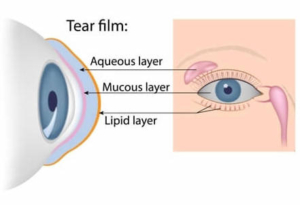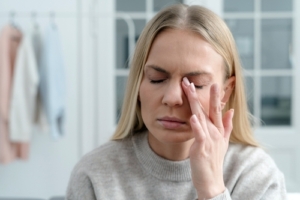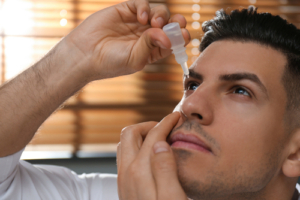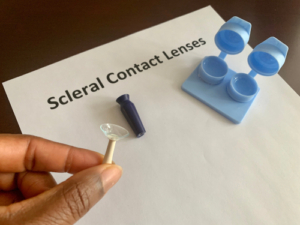What are the Best Ways to Treat Dry Eye Syndrome?
Do you constantly feel like there’s something stuck in your eye? Are your eyes itchy, red, and dry?
You may have dry eye syndrome. Dry eye syndrome is a chronic condition that occurs when your eyes produce insufficient tears or your tears evaporate too fast, causing persistent discomfort and dryness.
Dry eye symptoms can make you feel miserable and lower your quality of life. Keep reading to learn more about what causes dry eye syndrome, the signs of dry eyes, and the best ways to treat and alleviate your symptoms.
What Causes Dry Eye Syndrome?

You may wonder what’s causing your symptoms if you have dry eyes. Part of the issue lies with the tear film. The tear film has three layers:
Watery Layer
The watery layer of the tear film lubricates, nourishes, and protects your eyes. Lacrimal glands in your eyelids produce this layer.
Oily Layer
The oily layer prevents tears from evaporating from the surface of your eyes too quickly. It comes from the meibomian glands.
Mucus Layer
The mucus layer helps tears stick to the surface of your eyes. It also spreads evenly the watery layer over the surface of your eyes, keeping them moist. The creation of the mucus layer happens in the conjunctiva.
These three layers work together and ensure the surface of your eyes remains smooth, lubricated, and clear. If anything affects the balance and structure of your tear film, you may end up with dry eye syndrome.
Many factors can interfere with your tear film and cause dry eyes. For instance, about 70 percent of dry eye syndrome is because of evaporative dry eye. Evaporative dry eye occurs when the meibomian glands become blocked, making your tears evaporate quickly.
Signs of Dry Eye Syndrome
The signs and symptoms of dry eye syndrome include:

- Redness
- Eye fatigue
- Light sensitivity
- Gritty or sandy feeling in your eyes even if nothing is there
- Blurred or double vision
- Difficulty keeping your eyes open
- Stringy mucus around or in your eyes
- Difficulty wearing contact lenses
- Excessive tearing, which is your body’s response to the irritation caused by having dry eyes
Treatment for Dry Eye Syndrome
If you have dry eyes, your optometrist or ophthalmologist at Eye Consultants of North Dakota may recommend one or several of the following treatment options:
Over-the-Counter Eye Drops

For mild symptoms, over-the-counter artificial tears or eye drops may be all that’s required. They lubricate and hydrate your eyes, providing relief from dry, irritated eyes.
Warm Compresses
If the meibomian glands become blocked, it can cause dry eyes. Removing blockages in the meibomian glands with warm compresses will help alleviate dry eye symptoms.
To apply warm compresses, fill a bowl with warm water and put a clean washcloth in it. Then, wring out the excess water so it doesn’t drip before placing it over your eyes.
Once the washcloth gets cold, dip it in the bowl with warm water again, wring it out, and repeat the application several times.
The warmth of the compress unblocks the meibomian glands, which secrete oils that stop your tears from drying from the surface of the eye too quickly.
Although temporary, warm compresses can soothe your eyes and immediately relieve dry eye symptoms.
Eyelid Cleansers

You’ll find the meibomian glands along the edges of your eyelids. Sometimes, dirt, debris, and other contaminants build up on your eyelids, preventing oil in the meibomian glands from flowing into your eyes.
Consequently, this causes dry eyes. Using cleansers like Cliradex and Ocusoft can ensure your eyelids are clean, clearing them of pollen, mites, or other contaminants that may cause dry eye symptoms.
Dry Eye Medications
Your Eye Consultants of North Dakota optometrist or ophthalmologist may prescribe medications in the form of eye drops or pills to help stimulate tear production and help improve the quality of tears produced.
Punctal Occlusion
Punctal occlusion is a same-day procedure that closes off the tiny holes that drain tears from the eyes, called the punctum. The punctum is in the inner corner of your lower and upper eyelids.
During the punctal occlusion procedure, the punctum is blocked with biocompatible devices called punctal plugs. Punctal plugs are no larger than a grain of rice and can be temporary or permanent.
Temporary punctal plugs dissolve after a few days or months after insertion. If the temporary plugs alleviate dry eye symptoms, your optometrist or ophthalmologist may consider permanent punctal plugs.
Punctal plugs prevent tears from draining too fast, allowing you to retain more tears in your eyes. Increasing the number of tears keeps your eyes moist and lubricated, relieving dry eye symptoms.
Serum Tears
Serum tears are eye drops made using your blood. Your optometrist or ophthalmologist may choose to use them if you have severe dry eye syndrome that doesn’t respond to other treatment options.
The clear component from your blood sample gets extracted and mixed with a sterile saline solution. The solution creates serum tears. Serum tears have healing properties not found in other medications and proven to treat dry eye syndrome effectively.
Amniotic Membranes
Amniotic membranes have healing effects that address the underlying cause of your dry eye syndrome, reduce discomfort, and improve vision.
They’re made using placental tissue donated by a mother after childbirth.
A thin membrane of amniotic tissue is placed in a ring that resembles an oversized contact lens and fitted on top of your eyes. Placing the ring on your eyes allows amniotic membranes’ natural regenerative properties and therapeutic effects to heal a damaged cornea, scarring, and inflammation caused by dry eye syndrome.
Specialty Contact Lenses

Scleral lenses are specialty contact lenses that can aid your eyes in retaining moisture. These lenses are larger than traditional contacts and sit on the sclera, the white part of your eye.
Because of their size, scleral lenses can create a reservoir of fluid underneath them, where moisture accumulates. The moisture hydrates your eyes, alleviating dry eye symptoms.
Find Long-Lasting Relief from Dry Eye Syndrome

At Eye Consultants of North Dakota, we use the most advanced technologies to diagnose the root cause of your dry eyes. After your eye exam, your optometrist or ophthalmologist will tailor an effective treatment plan to ensure you enjoy healthy, clear vision.
Are you tired of living with the uncomfortable symptoms of dry eye syndrome? Schedule your appointment today at Eye Consultants of North Dakota in Fargo, ND, to get started on your journey to lasting relief.



